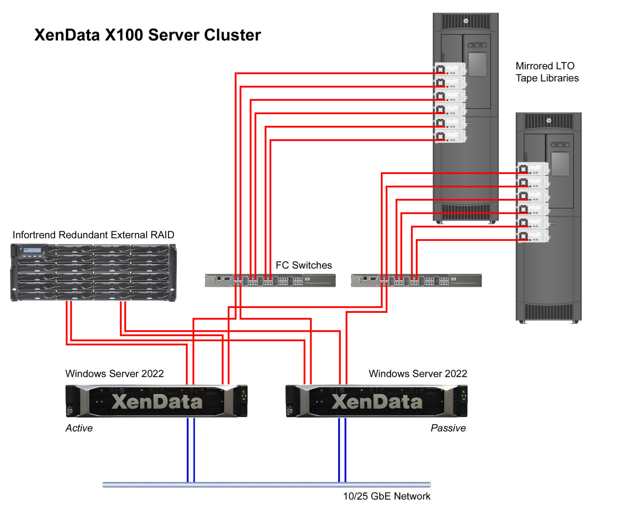XenData X100 Active Archive That Scales to 100PB+
For creative video, medical imaging, video surveillance and other applications with high volumes of large files, supporting libraries from HPE, IBM, Oracle, Qualstar, Quantum, Sony and Spectra Logic
This is a Press Release edited by StorageNewsletter.com on April 14, 2022 at 2:02 pmXenData, Inc. announces availability of the X100 active archive.
X100 manages highly scalable robotic libraries from
HPE, IBM, Oracle, Qualstar, Quantum, Sony and Spectra Logic
It manages one or more enterprise-class LTO or Optical Disc Archive (ODA) libraries that may scale to hundreds petabytes and is available in a configuration based on a Windows Server 2022 cluster with no single point of failure. It supports robotic libraries from HPE, IBM, Oracle, Qualstar, Quantum, Sony and Spectra Logic. It is for creative video, medical imaging, video surveillance and other applications with high volumes of large files.
It is powered by the company’s Archive Series software which is trusted by over 1,500 organizations in over 90 countries, including many of the largest media companies. The latest version of the firm’s software is optimized for performance servers with multiple Xeon processors.
X100 in cluster configuration managing 2 LTO libraries
The archive system includes a redundant RAID from Infortrend Technology, Inc. which was chosen for its performance. The RAID is used as a cache for all files written to the archive and is available with a capacity up to 280TB.
The X100 archive adheres to standards. It supports writing to LTO cartridges using LTFS and writes to ODA cartridges using the Sony interchange standard. It supports the Microsoft security model based on Active Directory, making it easy to install in an existing Windows domain.
The system has functionality including automatic LTO cartridge replication, file version control, automatic migration of files to the latest generation of LTO or ODA and management of an unlimited number of external cartridges.
When used with 2 LTO libraries, the system may be configured to mirror archived content across the libraries. This provides data protection which goes beyond a simple backup file repository, as file restores are load balanced between the 2 libraries.
X100 is available with 3 interfaces which can be used simultaneously:
- File-folder interface which scales to billions of files and hundreds of petabytes. Writing to and reading from this interface is like writing to a disk-based volume. It supports SMB, NFS, FTP network protocols as well as local file transfers.
- Object storage interface which is for remote access. It presents an S3 interface, supporting HTTPS and HTTP protocols.
- XML API which provides frame accurate timecode-based partial file restores for video archives. The XML instructions include the ability to pull assets from a source location and push them back to that location or another destination.
Multiple X100 systems may be synchronized using the company’s Multi-Site Sync service which links multiple archives in different locations, creating a single global file system accessible from anywhere. As soon as a file is archived to LTO or ODA at one location, it becomes available as a stub file within the global file system. When a user makes a change by writing, overwriting or deleting a file, that change is propagated to all locations. This provides an up-to-date set of files across the entire distributed organization.
Mark Broadbent, CTO and co-founder, commented: “The design of the X100 is based on everything that we have learned from the 1500+ XenData archives that have been installed WW. It uses a simple architecture which takes advantage of the power of today’s multi-processor servers.”
















 Subscribe to our free daily newsletter
Subscribe to our free daily newsletter


